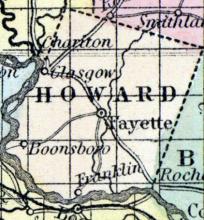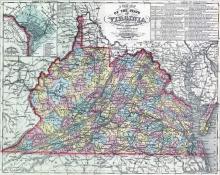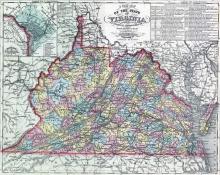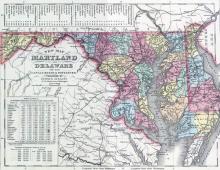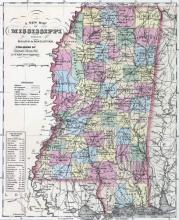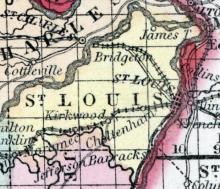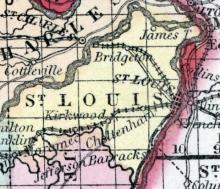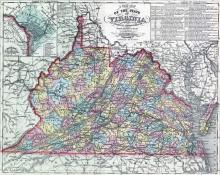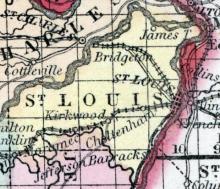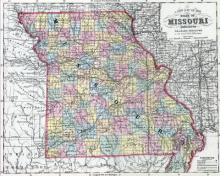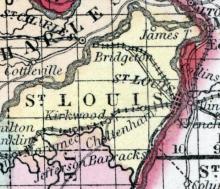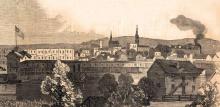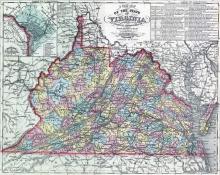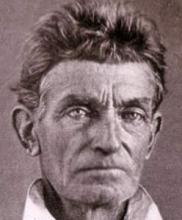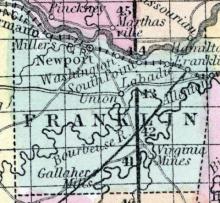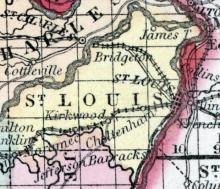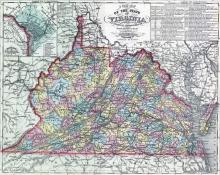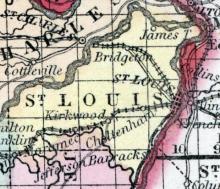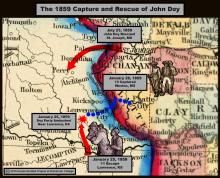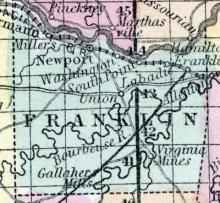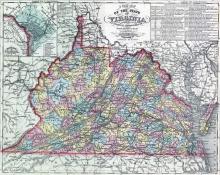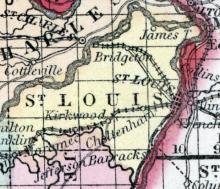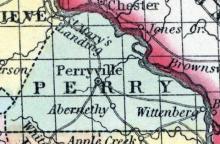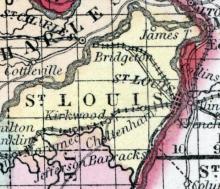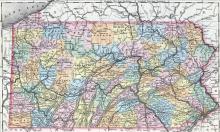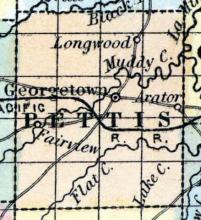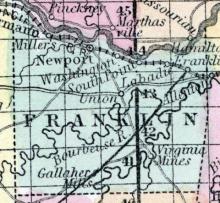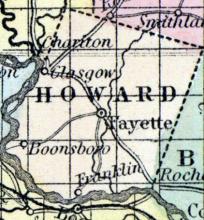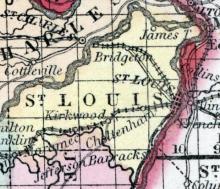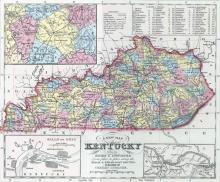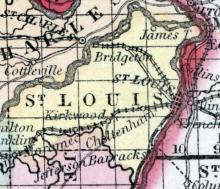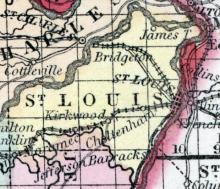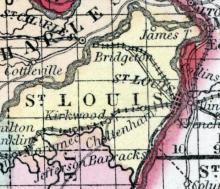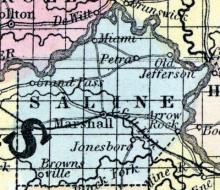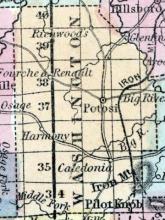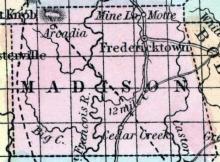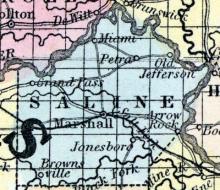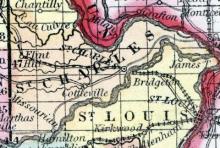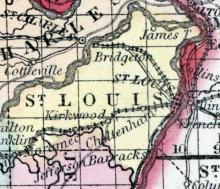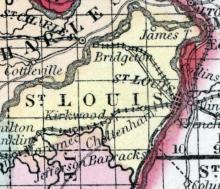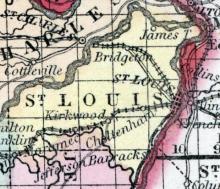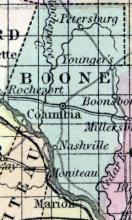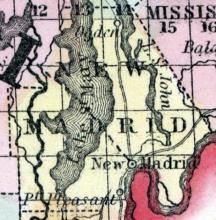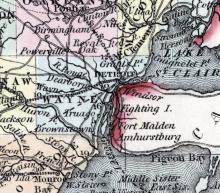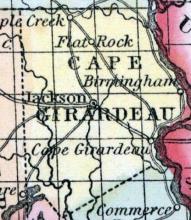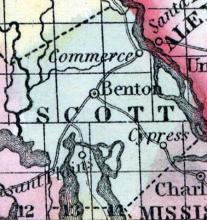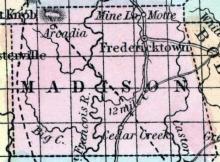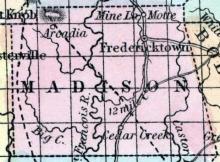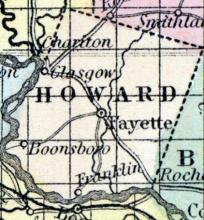A roughly 25-year-old enslaved man named Jordan escaped from Glasgow on Tuesday morning, August 10, 1858. His enslaver, Garrett W. Morehead, advertised a $200 reward for his recapture.
View All Escapes // 1840s // 1850s // 1860s
Displaying 251 - 300 of 314
On Saturday night, August 14, 1858, four Black men escaped from Hampshire County, Virginia in a reported "stampede." A local newspaper noted that the men had stolen four horses, which were eventually found near Cresaptown, Maryland.
On Saturday, August 14, 1858, six enslaved African Americans escaped from Barbour County, Virginia in a reported "slave stampede." Another four freedom seekers from Taylor County joined them on the same night.
On Tuesday, August 31, 1858, ten freedom seekers attempted an escape from West River near Annapolis, Maryland. Two were quickly recaptured but the rest of their group pursued them and after a "bold rush" and a "desperate fight," managed to liberate them temporarily. But according to news accounts, the fight left two Black men in the group "dangerously wounded," which "seemed to frighten and deter the negroes, because they as speedily as possible returned home to the
Senator Stephen A. Douglas of Illinois was married twice. His first wife Martha, who died in 1853, left him ownership of a large cotton plantation in Mississippi. This meant that Douglas, a powerful Democratic senator from a free state, was also a slaveholder in 1858, the year he campaigned against Republican Abraham Lincoln for reelection to the U.S. senate.
On Sunday, September 5, 1858, an enslaved man named Phil escaped from Fenton in St. Louis county, Missouri. His enslaver, Samuel T. Vandover, advertised a $200 reward for his recapture.
Sometime in September 1858, a 25-year-old enslaved man named Willis escaped from St. Louis. His enslaver, Charles McLarin, offered a "liberal reward" for his recapture more than a year later, when his aunt Maria also escaped.
Around Thursday, September 23, 1858, seven freedom seekers from Charlestown, Virginia (now West Virginia) were captured near Chambersburg, Pennsylvania. They were returned to their slaveholders and soon, according to news reports, sold to "purchasers from abroad."
On Sunday, September 26, 1858, a 35-year-old enslaved woman named Jane escaped from St. Louis along with her three children, a 7-year-old boy named Ed, a 4-year-old girl whose name was not recorded, and a 7-month-old infant. Her enslaver, J.H. Gordon, noted that Jane had a husband in Louisville Kentucky, and advertised a $500 reward for the recapture of Jane and her three children.
A group of 9 enslaved people escaped from Missouri, passing through Galesburg, Illinois. Roughly 5-6 of the group made it to freedom.
On Saturday night, October 9, 1858, an enslaved man named Aleck (alias Dock) escaped from Bridgeton, Missouri, opposite St. Charles. His enslaver, Francis St. Cin, initially offered a $200 reward for his recapture, but by November had raised the reward to $1,500.
Around Saturday, October 30, 1858, six freedom seekers ("valued at $7,500") escaped from around Parkersburg, Virginia (now West Virginia) and remained at large. Local newspapers blamed the "stampede," on "free negroes, who are fast getting to be an intolerable nuisance."
Sometime in late October, ten freedom seekers, including five men, three women and two children, escaped from Prunytown, Virginia (now West Virginia) with "seven other chattels in the shape of horses." According to news reports, "They left the horses after the night ride and steered for the North Star on foot," until they were confronted by slave catchers in Fayette County, Pennsylvania. The group then engaged in "a desperate fight for freedom" and ultimately escaped. &
On December 20, 1858, abolitionist John Brown and a group of armed activists led a raid into Vernon county, Missouri, at the behest of enslaved Missourian Jim Daniels who was owned by James Lawrence. The raid freed Daniels, his family and several other enslaved people, 11 in total (12 following the birth of John Brown Daniels), escaping westward through Kansas.
On New Year's Day 1859, a 38-year-old enslaved blacksmith named Sam escaped from Union in Franklin county, Missouri. His escape route took him within the vicinity of Manchester, St. Louis county. Sam's enslaver, A.W. Maupin, advertised a $400 reward for his recapture. He later increased the reward to $600.
On New Year's Day 1859, a 21-year-old enslaved man named Joe escaped from the property of slaveholder John Quesenberry, roughly 12 miles northwest of St. Louis along the St. Charles Rock Road. Quesenberry advertised a $50 reward for Joe's recapture.
Around Saturday, January 1, 1859, five freedom seekers fled Fairmont, Virginia (now West Virginia) heading toward western Pennsylvania. A local newspaper report labeled this a "Negro Stampede" while observing that the five runways "took a fine horse" from one of their slaveholders. This escape from what was then known as the "Virginia Panhandle" was only one of many stampedes during the period. Another newspaper noted: Our 'Mountain county' exchanges bring us
On Wednesday, January 5, 1859, a 20-year-old enslaved woman, who was not identified by name, escaped from St. Louis. Her enslaver, George Smizer, assured readers that he would "pay a liberal reward" for her apprehension.
On January 25, 1859, abolitionist John Doy, two free African Americans Wilson Hays and Charles Smith, attempted to lead 11 freedom seekers from various locations across western Missouri to freedom in Iowa. They were recaptured near Lawrence, Kansas. Doy was later rescued from prison to great fanfare, while Smith and one of the freedom seekers, Bill Riley, also managed to escape Missouri authorities. The others, however, were not so fortunate, and apparently sold down to the Deep South.
An enslaved man named Henry, aged about 17 years, escaped from Gray Summit in Franklin County, Missouri sometime during late February 1859. His enslaver, Charles W. Jeffries, advertised a $200 reward for his recapture.
Sometime in February 1859, there was a report that 23 freedom seekers escaped from the Virginia panhandle (now West Virginia), passing through Waynesburg, PA on their way toward Canada. According to a newspaper report, the runaways "were hotly pursued, but contrived to make good their escape." The report added, "A number more were piloted over the underground railroad some days before, in the same county."
In March 1859, a 26-year-old enslaved woman named Therese Bonter escaped from St. Louis. Her enslaver, Elizabeth Eddy, advertised a $300 reward for her recapture.
On Saturday night, March 19, 1859, a 22-year-old enslaved man named Elam escaped from Allenburg in Perry county, Missouri. His enslaver, Daniel W. Milster, advertised a $250 reward for Elam's recapture.
On Monday, March 28, 1859, a roughly 25-year-old enslaved man named John escaped from St. Louis. His enslaver, William Carpenter, advertised a $200 reward for his recapture through an agent.
After U.S. authorities arrested alleged runaway Daniel Webster in Harrisburg, Pennsylvania in early April 1859, reports described a "stampede" of fugitive slaves who had been residing in the city.
An enslaved man named Jim, in his late 20s, escaped from Washington in Franklin county, Missouri. His enslaver, George L. Barnes, advertised a $200 reward for his recapture.
On Sunday, April 24, 1859, an enslaved man named Peter escaped from a property near Rocheport in Howard county, Missouri. His enslaver, John L. Jones, advertised a $200 reward for Peter's recapture.
Two enslaved women, Sophia and Corbella, escaped from St. Louis with the help of a free African American man, John Cash, who disguised them in men's clothing. The planned escape reportedly went awry, and the women were apparently recaptured.
On Saturday, May 21, 1859, four Black men from Cynthiana, Kentucky "made a break" for the Ohio River. Two of them succeeded by crossing near Augusta, Kentucky, but the other two were caught. Local newspapers described this effort as a "stampede of slaves."
On Thursday, June 2, 1859, a roughly 24-year-old enslaved woman named Rachel escaped from the Nutt Farm on St. Charles Plank Road outside of St. Louis. Rachel's enslaver, William W. Henderson, advertised a $100 reward for her recapture.
On Saturday night, June 4, 1859, three enslaved men, 21-year-old Washington, his 18-year-old brother Jim, and another enslaved man named Ned, escaped from St. Louis. Washington had escaped five years earlier from slaveholder D.M. Frost's father-in-law, Richard Graham, only to be arrested in Indiana for grand larceny and reclaimed by Frost. This time, Frost advertised $1,500 for the recapture of Washington and Jim.
On Thursday afternoon, June 23, 1859, a 10-year-old enslaved girl named Caroline "strayed" from the household of her enslaver, L.M. Shreeve. The St. Louis slaveholder promised that anyone who recaptured Caroline "will be liberally rewarded."
On Sunday night, July 10, 1859, a roughly 30-year-old enslaved man named Sim escaped from a property roughly three miles east of Marshall, in Saline county, Missouri. His enslaver, Henry C. Simmons, postulated that "it is possible that he is in company with a white man," and advertised a $300 reward for Sim's recapture. Sim was arrested a week later on July 17 in St.
On Saturday night, July 16, 1859, a 21-year-old enslaved man, who was not named, ran away from Hopewell in Washington county, Missouri. His enslaver, John Hunt, advertised a $50 reward for his recapture.
On Saturday night, July 16, 1859, two enslaved men, 26-year-old Jeff and 23-year-old Allen, escaped from Waverly, Missouri aboard a skiff, reportedly bound for Alton, Illinois with the intention of taking the Alton and Chicago Railroad to Chicago. Their enslavers, the firm of Melton & Woods, advertised a $500 reward for the recapture of Jeff and Allen.
On Saturday, July 16, 1859, four enslaved men, 22-year-old George, 21-year-old Smith, 32-year-old Tom and 28-year-old Isaac (or "Ike"), escaped from Fredericktown, Missouri. Their enslavers, James Hill, Sr. and C.J. Buford, advertised a $1,200 reward for the recapture of the four men.
On Sunday, July 24, 1859, five enslaved people, Caeser, Charles, Dan, John and Ann, ran away from a property located 16 miles west of Arrow Rock, Missouri. Their enslaver, Osamus Hunt, advertised a $500 reward for their recapture.
On Saturday night, July 30, 1859, two enslaved men, 35-year-old Ben and 24-year-old Jeff, escaped from Wellsburg in St. Charles county, Missouri. Their enslavers, John T. Overall and Travis Murphy, advertised a $500 reward for Ben and Jeff's recapture.
A 35-year-old enslaved man named Jesse Henry escaped sometime in July 1859. His enslaver, E.C. Sloan, advertised a $500 reward for his recapture.
On Saturday, August 13, 1859, a roughly 23-year-old enslaved man named William escaped from Fenton, southwest of St. Louis. His enslaver, Samuel Vandover, advertised a $200 reward for William's recapture.
On Thursday, August 18, 1859, a roughly 37-year-old enslaved man named Bob escaped from a property "in sight of St. Louis." His enslaver, Thomas H. Noble, advertised a $200 reward for Bob's recapture.
On Saturday night, August 20, 1859, three enslaved men, 28-year-old Scipio, 35-year-old Leavin and 35-year-old Lewis, escaped from a property located seven miles below Providence, Missouri, along the Missouri river. Their enslavers, S.W. Warren, D.H. Hickman and J.D. Herndon, advertised a $1,500 reward for their recapture.
An antislavery vigilance operative in Detroit publicly boasted on September 28 that "quite a stampede" of more than fifteen freedom seekers had just passed safely through the city.
On Monday night, September 5, 1859, two enslaved men, 24-year-old Jim and 20-year-old Alfred, escaped from the steamer John Walsh as it was passing the vicinity of Cape Girardeau. Their enslaver, B.M. Lynch, advertised a $600 reward for their recapture.
On Monday morning, September 5, 1859, two enslaved men, 27-year-old Jack and 23-year-old Solomon, escaped from the town of Benton, in Scott county, Missouri. Their enslavers, Parrot & Crow, advertised a $300 reward for their return.
On Friday, September 9, 1859, an enslaved man named Jasper Kinney, around 21 years old, escaped from Mine La Motte in Madison county, Missouri. His enslavers, R.F. & T.F. Fleming, advertised a $300 reward for his recapture.
Five enslaved people escaped from near Fredericktown, Missouri, and was overtaken by a group of white Missourians between Chester and Sparta, Illinois. One of the freedom seekers was killed in the fray, and two more were wounded, leading to the arrest of one of the white Missourians.
On Saturday night, October 8, 1859, two enslaved men, 40-year-old Elijah and 28-year-old Simon, escaped from Glasgow, Missouri. Their enslavers advertised a $200 reward for Elijah and Simon's recapture.

